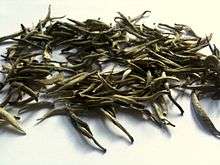Baihao Yinzhen
 .jpg) | |
| Type: | White |
| Other names: | Silver Needle White Hair Silver Needle Yinzhen |
| Origin: | Fuding and Zhenghe counties, Fujian Province |
| Quick description: | The highest grade of White tea, Bai Hao Yin Zhen, should be fleshy, bright colored and covered with tiny white hairs. |
|
|
Baihao Yinzhen (simplified Chinese: 白毫银针; traditional Chinese: 白毫銀針; pinyin: báiháo yínzhēn; pronounced [pǎi̯.xǎu̯ ǐn.ʈʂə́n]), also known as White Hair Silver Needle, is a white tea produced in Fujian Province in China.[1] Amongst white teas, this is the most expensive variety and the most prized, as only top buds (leaf shoots) are used to produce the tea.[2] Genuine Silver Needles are made from cultivars of the Da Bai (Large White) tea tree family. There are other productions that look similar with downy leaf shoots but most are green teas, and as green teas, they taste differently and have a different biochemical potency than the genuine white tea Silver Needle.[3] It is commonly included among China's famous teas.
Production
A genuine Silver Needle is a white tea. As such, it is only lightly oxidized.[4] The most sought after productions are from the first flushes, which generally take place between late March to early April,[2] when the year's first new buds "flush". For the production of Silver Needle, only the leaf shoots, i.e. the leaf buds before opening, are plucked.[3][5] Unlike the plucking of green tea, the ideal time and weather for plucking white tea is a sunny morning when the sun is high enough to have dried any remaining moisture on the buds.[5]
Traditionally, the plucks are laid in shallow baskets to wilt under the sun for an extended period, and the best quality produced today are still made this way.[5] To avoid loss due to sudden rain, gusts, or other accidents, some producers are taking the plucks indoor to wilt in a chamber with artificial warm air flow. The softened shoots are then piled for the required enzyme oxidation (often incorrectly referred to as fermentation) before they are taken for a low temperature bake-dry.[3]
Two regions, Zhenghe and Fuding, spanning the north to north-eastern parts of the Fujian province are the major and original producers of this tea, although neighboring counties have also been producing.[3] The two major cultivars employed by these regions are Fuding Da Bai and Zhenghe Da Bai, named after their origins. These differences are important to distinguish the two major styles of Silver Needles — the Zhenghe style and the Fuding style. The former is usually a lot darker, with significantly longer piled-up time for oxidation, yielding a tea with fuller body than the latter style, which is generally lighter with shorter oxidation.[5] The character of the tea tree leaves of the former allows for the extended piled-up time without turning bad. Both styles have their own group of followers, as taste is a rather personal preference.
Brewing
As with all white teas, it is best prepared with water below boiling (at around 75 to 80 degrees Celsius or 167 to 176 degrees Fahrenheit)[6] and produces a slightly viscous glittering pale yellow color with evidence of floating white hairs that reflect light. Baihao Yinzhen is said to smell of "fresh-cut hay", and the flavour is described as sweet, vegetal, and delicate.[7] Steeping should be longer than other white teas; up to 5 minutes per brew, and the volume of tea to be used can be higher. There are few parallels to be drawn as the taste is not similar to any other teas but Bai Mu Dan, except the latter is fuller but not as sweet and delicate.
References
- ↑ Huang, Lingyun (2009). Tao of Chinese tea: A cultural and practical guide. Pleasantville: Reader's Digest Association. p. 79. ISBN 9781606520505.
- 1 2 陳宗懋,中國茶經,pp 236,上海文化出版社,1992
- 1 2 3 4 袁弟順,中國白茶,廈門大學出版社,2006
- ↑ Joseph Needham, Science and Civilization of China, V.6, P.V, Fermentations and Food Science, pp551, Cambridge University Press, 2000
- 1 2 3 4 陳宗懋,中國茶經,pp 426-427,上海文化出版社,1992
- ↑ "Brewing Tips and Tea Information". ADORE TEA. Retrieved 17 February 2014.
- ↑ Gascoyne, Kevin; Marchand, Francois; Desharnais, Jasmin; Americi, Hugo (2011). Tea : history, terroirs, varieties (1st print. ed.). Richmond Hill, Ont.: Firefly Books. ISBN 9781554079377.
See also
External links
- Linus Pauling Institute on white tea
